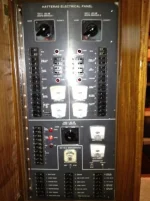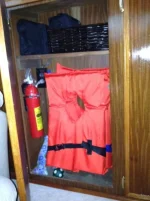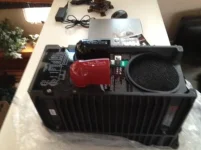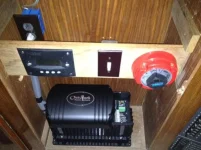chris piazza
Well-known member
- Joined
- Mar 24, 2006
- Messages
- 589
- Hatteras Model
- 53' CONVERTIBLE (1969 - 1980)
I have decided to add a Outback inverter to the boat. Not being the sharpest tool in the shed I have read all the threads on inverters and I still don't quite get it. I realized that it probably should not be mounted in the engine room because of the heat and possible moisture. I think I have found the perfect location in the pictured cabinet which is located next to the pictured electric panel in the Salon. Both cabinets are right above the main battery switches in the engine room. I would like to have the inverter run small appliances, a few outlets, master stateroom and master head, two refrigerators, and davit. I also have an outlet on the bridge that powers my wave rouge and router as well as a small 12v charger for aback up battery for electronics. In the threads I have read there has been a lot of discussion on weather to run one bank or two to power the inverter, I was just going to use one bank because 95% of the time the inverter would be used when the boat is running. Also I don't understand what the "mate" option is and do I need it? Final question is can someone explain the best way to wire the inverter to the main panel, I don't have a 2nd generator switch as some do so I have no clue as how to do this. I don't think I want to use the "pass through" option, just keep it as simple as I can. Ok for some reason my two pics wont upload, I'll keep working on that.
Chris
Superior Nights 53c
Chris
Superior Nights 53c





